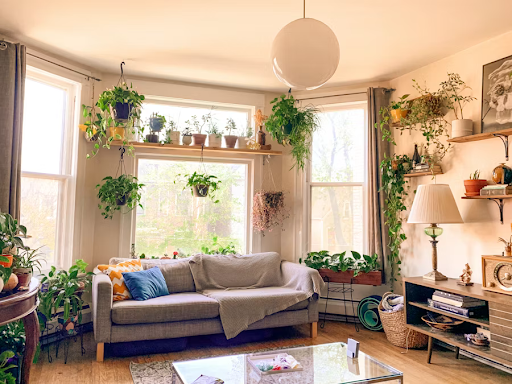
You want the lush, effortless vibe of a magazine spread… without turning your living room into a horticulture classroom. Plants make a space feel finished, human, alive. But do you go faux and sleep easy, or go real and roll up your sleeves? Here’s a fresh, no-fluff take to help you decide what actually fits your home, habits, and light.
Some links in this post are affiliate links, which means I receive a commission if you make a purchase.

Via Unsplash
The Aesthetic Hack You’re Chasing
Real plants bring movement. Leaves unfurl, shadows shift, and there’s a micro-drama happening on your windowsill. Faux plants bring certainty. That sculptural monstera won’t suddenly sulk after a weekend away. If your style leans minimal and controlled, faux keeps lines crisp. If you love a bit of wild, real greenery adds the beautiful chaos that makes a room breathe.
Maintenance: Be Honest With Your Calendar
Watering schedules look easy on Pinterest. In real life? Meetings. School runs. Holidays. If you can commit to a routine, start with resilient greens: snake plant, ZZ, pothos. They forgive. If your calendar owns you, high-quality faux is not a cop-out; it’s design realism. Dust them monthly with a microfiber cloth and a quick blast from a hairdryer on cool. Done.
Light, Air, and the Well-Being Question
Yes, live plants can lightly improve air quality, but the real magic is mood. Caring for something living nudges you to slow down. That ritual matters. No bright windows? Don’t punish shade-hating tropicals. Instead, place a faux statement piece where real plants would struggle—above kitchen cabinets, in a dark hallway, on a bookcase far from the window—and reserve your best natural light for the real divas.
Safety, Scale, and the Commercial-Grade Secret
Fire safety often gets ignored in home decor. If you’re adding tall faux specimens near curtains or in rental properties, look for options like IFR palm trees (inherently fire-retardant). They’re designed to keep their flame resistance for the life of the product and let you style big, breezy resort vibes without the risk. Scale matters too: oversized greens shrink a cavernous room to human scale, while a row of small plants can visually “stitch” a long shelf together.
Cost vs. Longevity: Do the Math
Real plants feel cheaper up front, but plan for pots, soil, fertilizer, and the occasional replacement after an overwatering episode. Faux has a higher entry cost, yet holds its look for years. The smart play? Hybrid strategy. Invest in one or two premium faux anchors for tricky zones (high shelves, dim corners) and rotate a few live plants in your brightest spots. You’ll get freshness without constant triage.
Texture Games: How to Make Either Look Expensive
Think in layers. Mix glossy leaves with matte pottery. Pair trailing vines with chunky stone. Elevate planters on stands to give plants a “stage.” For faux, break up perfection: bend stems, vary heights, and add a small pot of real moss on the soil surface for a believable finish. For live plants, group odd numbers and vary leaf sizes so the eye travels.
The Verdict: Design by Intent, Not by Dogma
There’s no decor award for keeping everything alive, and no shame in using a great fake. The real win is a home that supports your life. If you crave ritual and growth, nurture a few living plants where they’ll thrive. If you crave calm and reliability, choose quality faux where they’ll shine. Blend both and you get a space that looks good on Monday morning and feels good on Friday night. Pick your battles. Curate with care. Let your greenery—real or faux—do what great design always does: make you exhale.
This is a contributed post.
More From NeededInTheHome
Product Reviews
Get Our Books
Etsy Shop
TPT Store
eBay Store
Linktree
My Faith Testimony
Subscribe so you never miss a post.
If you find my tips useful, feel free to buy me a coffee. Thank you in advance!
Want to remember this? Pin it to your favorite Pinterest Board!

Join the newsletter
Subscribe to receive our latest articles and promotional content by email from NeededInTheHome
Leave a Reply